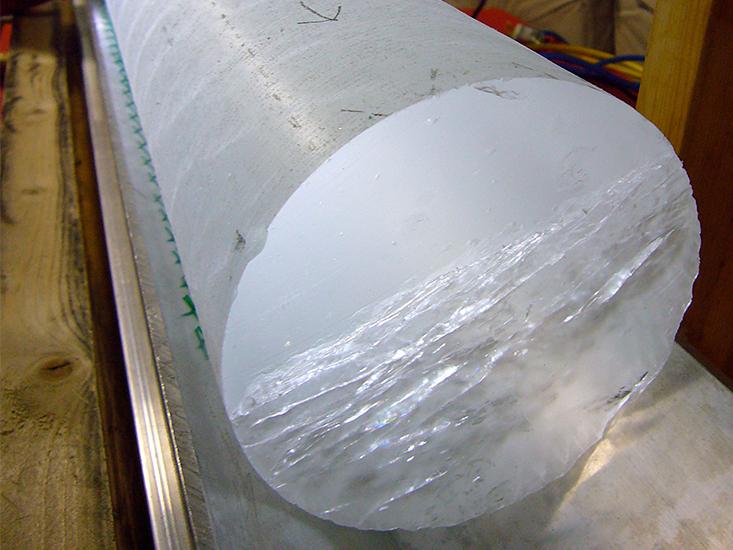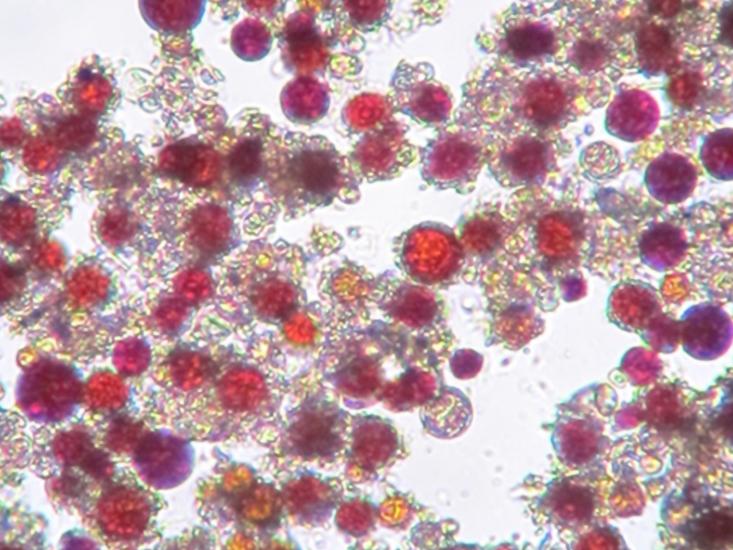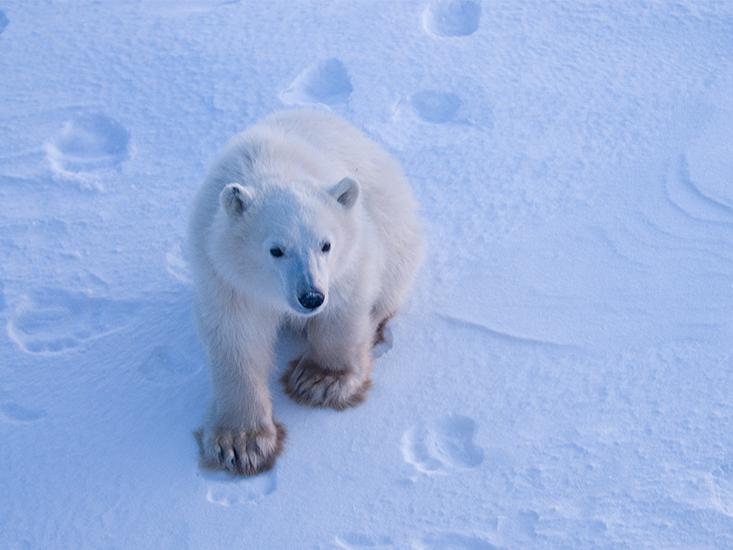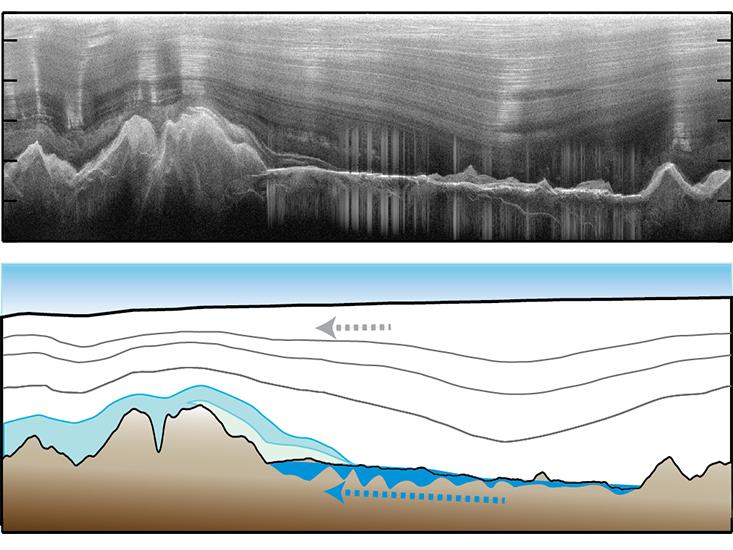When we think of storing information today, we conjure up rows of giant computer servers that house endless streams of digital data. All the world’s information, it seems, will one day be preserved as ones and zeros in permanent, stable, and indestructible devices. So it may sound strange that ice, an ephemeral, unstable, and brittle substance, has been one of the world’s most permanent means of information storage. The cloud, in fact, has nothing on ice. Ice holds the key to understanding how the climate has changed over millions of years, and may change Earth in years to come. We asked a host of scientists to help us thaw out the information.
Climate Records

The hardened plains and peaks of ice that make up Greenland and the Antarctic preserve information about Earth’s former climates, going back millions of years. As snow accumulates in these regions year after year, the higher snow layers exert pressure on the lower ones, squeezing out air. Under pressure, snowflakes transform into dense grains of ice that fuse together into glacial sheets.
But not all the air escapes. About 10 percent of it gets trapped when snowflakes transform into ice crystals. Those miniscule air bubbles contain the atmospheric gases—nitrogen, oxygen, carbon dioxide, methane—from the time periods in which they were trapped. Climate researchers are particularly interested in the greenhouse gases.
“Ice cores are the primary way in which we reconstruct the atmosphere going back a million years or so,” says paleoclimatologist James White, professor at the University of Colorado, Boulder and director of the Institute of Arctic and Alpine Research. “It’s one of the few archives of the past that is clean enough that you can actually get carbon dioxide and methane concentrations.”
Retrieving information from ice cores is labor-intensive. The oldest ice core, dating back about 890,000 years, is a cylinder of ice over 3,000 meters long (almost 10,000 feet); it was extracted in 2004. In the lab, researchers crush samples of the cores in vacuum containers to release the trapped air and measure the concentration of the gases released.
By studying the contents of the trapped air bubbles researchers can understand how the levels of greenhouse gases have changed over time. “That helps us understand the physics of how the climate system behaves,” White explains. From there, they can hypothesize how the various amounts of greenhouse gases being released in the atmosphere today will affect the future climate.
Warning Blooms

Those red, yellow, green, and black spreads that you see on glacier snow and ice are caused by various species of algae. And those colorful spores have a message for us.
Algae make colorful pigments in order to survive. When the sun melts the ice on glacier tops in summer, the algae spores come up to the surface from within the ice. When algae first transform from spores into active photosynthesizing organisms, the chlorophyll in their bodies makes them green. But then algae start producing different pigments to protect the chlorophyll from too much sun. “It’s like when you go into the sun and you get too much of it, you put sunscreen on,” says Liane Benning, a biogeochemist from the University of Leeds. “This is their sunscreen.”
Five years ago, scientists discovered ice algae, which color ice black. “People just assumed it was dirt,” Benning says. “Once they looked at it in terms of the biological component, they [found] a very specific pigment that keeps algae black.”
The colored ice absorbs more sun than white ice, and melts faster. “Algae speed up the melting rate, and if you melt more, you have more nutrients in the water for algae to grow,” Benning says. This melt-induced algal growth causes a reduction of up to 20 percent in albedo—the proportion of the light reflected by a surface—becoming a self-perpetuating loop.
Benning explains that snow and ice algae are blooming more often, more densely, and in larger areas than ever. That’s an indication, she says, “that ice is melting faster, and algae obviously help the faster melting.”
Love Notes

Polar bears are solitary animals that need some way of finding each other during mating seasons. Unlike brown bears, who mark their forest territory by rubbing their backs against trees or rocks, polar bears have never had vertical structures on which to leave scents, says George Durner, a research zoologist with the United States Geological Survey’s Alaska Science Center. Instead they evolved to leave mating cues in the ice.
Together with Durner and colleagues, Megan Owen, a behavioral ecologist at the San Diego Zoo, studied how polar bears find each other through notes left in ice. Owen and her team gathered and catalogued samples of polar bear footprints in Alaska and let zoo bears sniff them. Owen says males were clearly more interested in the scents collected from females, and, in particular, in scents from females that weren’t nursing young cubs and would be available for breeding. Both males and females undergo significant hormonal changes during the breeding season, and the scents left in ice indicate their availability to mate. The scents of tracks left by male bears can sound an alarm for mothers with cubs, because aggressive male bears can kill the young.
Owen is still studying the biochemical compounds polar bears use to write their messages. Polar bears have large sweat glands on their paws—larger than anywhere else on their body—so they definitely pass some information through sweat. But the full message is probably a mix of various metabolic byproducts of bears’ biochemistry, Owen says. “It’s a combination of sweat and urine and body odor that reflects the biochemistry of that reproductive status and that time of year,” she says. “That’s the information content.”
One factor though, is changing the delivery of the message. Warming temperatures are thinning the arctic ice and causing fractures. “Suddenly you get a bunch of breaks,” Durner says. “Tracks are disrupted. The physical nature of the seascape becomes more difficult for bears to travel on, and reduces the ability of bears to communicate effectively.”
Eternal Mountains

In the heart of Antarctica lies the Gamburtsev Mountain Range, roughly the size of the European Alps, which, as researchers discovered last year, has not changed for 34 million years. Usually, natural forces like water and wind erode the rocks, but Gamburtsev has been spared the erosion. The three-mile thick ice encasement that covers the range preserved it, because of how water and ice interact in the concaved, spoon-like valleys.
The heat that emanates from earth melts the ice in the bottom of the valleys between the ridges. This creates a pool of water underneath the ice. The pressure of the heavy ice sheet on top of the water pool pushes it in various directions. Because the meltwater sits on a hard rock surface, it can’t trickle down. The weight of the ice sheet pressing against the water causes it to flow uphill—following the path of least resistance, says glaciologist Timothy Creyts at Lamont-Doherty Earth Observatory. “All [water] wants to do is just find a preferred path and flow in that preferred path, which is outward,” he says. As this water moves up, it reaches the ridges, where the ice is thinner and the temperature is colder. There, the water refreezes. The force of the ice sheet causes the newly hardened meltwater to hug the curves of the ridges as it flows over them.
Creyts and his colleagues at Lamont-Doherty Earth Observatory say this process has kept the Gamburtsev Mountain Range in its youthful form, making it the oldest place on the planet still looking so young. While the rest of the earth keeps changing, Creyts says, the Gamburtsev’s range ice will likely continue to preserve the snapshot of the prehistoric earth. Unless, that is, increased warming finally causes the snapshot to fade.


























